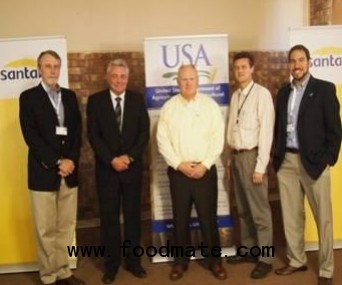Mr. Norton's visit started on August 29th with a meeting with Dr. John Purchase, CEO of Agbiz, a voluntary association representing agribusinesses in South Africa. John gave Jerry an excellent overview of the agricultural policy environment in South Africa after the impacts of the U.S. drought on global grain supplies and food prices were discussed. The next meeting was with Eugene du Preez of SIQ and Fanie Ferreira of GeoTerraImage. They are both members of the National Crop Statistics Consortium (NCSC) that have over the past eight years supported the South Africa’s Department of Agriculture with annual domestic grain crop estimates. Both gentlemen gave Mr. Norton an insightful overview of the crop estimates methodology used in South Africa.

In the afternoon Mr. Norton spent time with GrainSA, South Africa’s grain and oilseed producer association. The meeting was educational and technical of nature and the focus was on the working of the WAOB and on data gathering and analysis. Jerry made a short presentation on the working of the WAOB as introduction, which was followed by a in depth discussion on supply and demand database systems.
The timing of this activity could not be better as the grain industry recently formed a working group to develop an official supply and demand database for grains in South Africa. Today, the industry and every grain trading company make their own supply and demand projections based on the estimates by the South African Crop Estimates Committee. The industry, however, is looking for a system, similar to USDA’s current system, which can produce official supply and demand estimates.
The next day it was off to Bothaville in the centre of the grain producing area of South Africa.FAS/Pretoria in collaboration with Santam Agri, organized a seminar on “The Global Grain Market Outlook” for farmers and agribusinesses with Mr. Norton as the keynote speaker. Over 100 peopleattended the seminar. The event gave an insight to farmers about the global outlook and the impact of the U.S. drought. Many farmers expressed how this was a unique lifetime opportunity to hear from an U.S. expert how South African farmers can benefit from this market situation during the upcoming 2012/13 marketing year.
On the Friday it was back to Pretoria for a business lunch meeting, organized by AfricaBio in collaboration with FAS/Pretoria. AfricaBio is an independent, non-profit biotechnology stakeholders association and an important contact for FAS/Pretoria. Their key role is to provide accurate information and create awareness, understanding as well as knowledge on biotechnology and biosafety in South Africa and the African region. Participants at the business lunch meeting included government officials, farmers, delegates from seed companies, academics and other stakeholders. About 60 people attended the lunch. Mr. Norton presented on the effect biotechnology crops have had on trade since the late
1980’s. The discussion took place during a time where Africa has turned the corner in terms of biotechnology and a sense of urgency is felt in several countries in the region including Mozambique, Kenya, Malawi, and Uganda.
Jerry Norton ended his trip by delivering his keynote presentation at the 12th South African Agricultural Outlook Conference on September 4. At the conference, he spoke about the global outlook for the supply and demand for grains and provided key information on the global corn and wheat supply and demand situation. Jerry addressed an audience of approximately 300 attendees, including farmers, agricultural business and industry experts, international organizations, government representatives, academics, commercial banks and media. Mr. Norton's visit to South Africa made the conference even more relevant as at it came during a time when both locally and globally, there has been a lot of speculation about the impact of the U.S. drought on global grain supplies. This opportunity not only gave USDA a chance to explain the situation with a global perspective, but also allowed FAS/Pretoria to build up the relationship with important contacts by ensuring them an opportunity to meet with a high ranking member of USDA.





